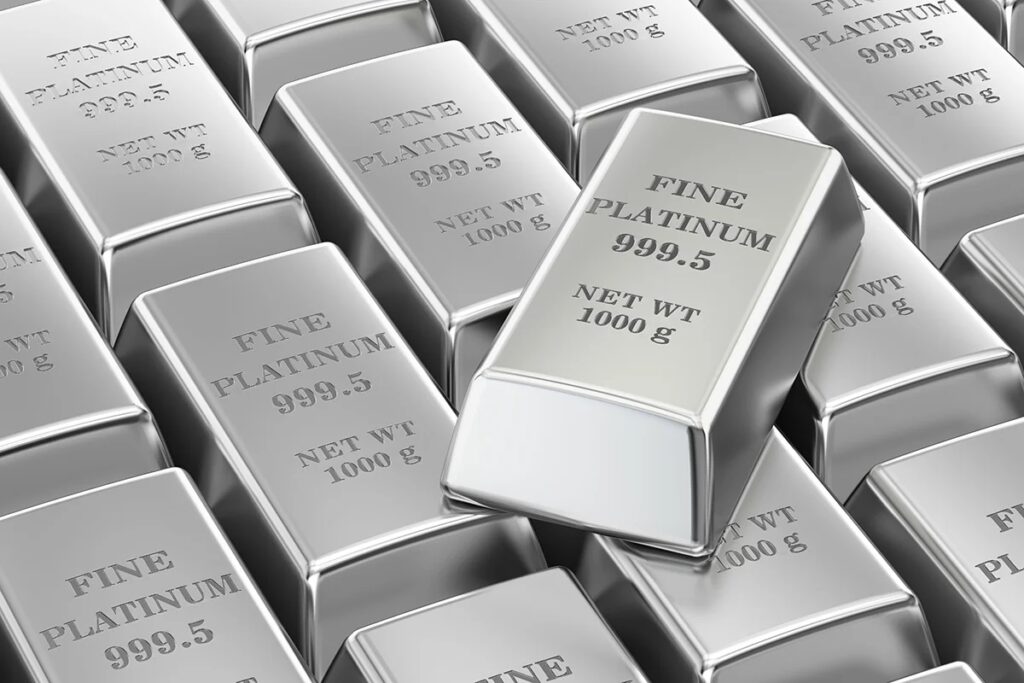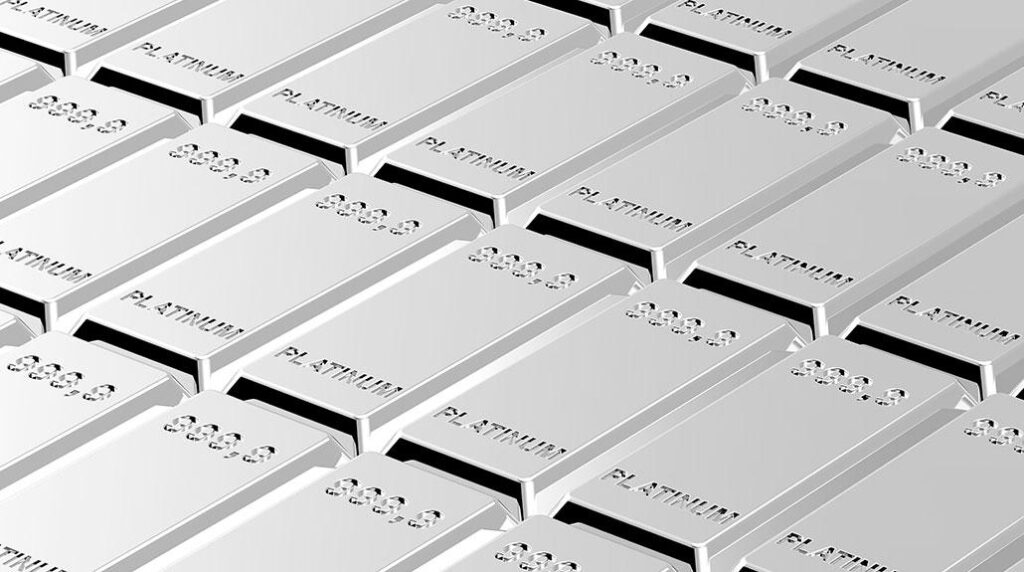Investing in platinum is a topic that requires a comprehensive understanding of various factors, including the metal’s properties, market dynamics, historical performance, and future outlook. Platinum is a precious metal with unique characteristics that differentiate it from other investment options like gold and silver. So, is platinum a good investment?
In this detailed exploration, we will delve into the reasons is platinum a good investment or not.
While platinum mining has not been done for thousands of years, gold mining has. Platinum wasn’t discovered until 1735 due to its higher boiling point and the rarity of it occurring in its natural form.
Northern South African mines produce the majority of the world’s platinum. It’s difficult to extract. Rarely is platinum found alone; instead, it is typically found with other basic metals including nickel, copper, and chrome.
Underground deposits have to be refined before they can be regarded as pure, and platinum is very uncommon due to the difficulty of this procedure. The final destination of this commercial-grade metal determines how platinum is used. The automobile industry is the intended use for about 40% of platinum.
Catalytic converters, a contemporary necessity in the fight against hazardous emissions, are primarily made from it. It is utilized to a lesser extent in the fuel cells of the most recent electric vehicle models.
As one might anticipate, approximately 31-38% of it is turned into jewelry. Customers who think platinum is better than gold find it very appealing because of its scarcity and expensive cost. A fifth is accounted for by industry. Platinum is included in a wide range of products, including pacemakers and fertilizer. Bullion is made out of the remaining portion. To create platinum bars and coins for the investment market, anywhere from 2 to 11% is employed.
Properties of Platinum
Platinum is a rare and valuable metal with a distinct set of physical and chemical properties. It is known for its lustrous, silver-white appearance and is highly resistant to corrosion. One of platinum’s most significant characteristics is its catalytic properties, making it essential in various industrial applications, particularly in the automotive industry for catalytic converters.
Market Dynamics
The platinum market is influenced by several factors, including supply and demand, geopolitical events, economic indicators, and technological advancements. The majority of the world’s platinum production comes from South Africa, with Russia and Zimbabwe also contributing significant amounts. The automotive industry’s demand for platinum, particularly in catalytic converters, plays a crucial role in the metal’s market dynamics.

Historical Performance
Historically, platinum has often been overshadowed by gold and silver in terms of investment appeal. While gold is considered a safe-haven asset and silver is an industrial and precious metal, platinum’s primary demand comes from industrial uses. However, there have been periods when platinum outperformed other precious metals. For example, during certain economic conditions, such as robust global growth, the demand for platinum in industrial applications can drive its price higher.
Is the Price of Platinum Volatile?
If you’re wondering if platinum is a viable investment, you should know that the market is very volatile, even more so than the gold market.
South Africa is the primary location for platinum mining worldwide. The second-largest supplier is Russia. Smaller-scale platinum mining is also conducted in Montana, Canada, and Zimbabwe. However, the supply of platinum has been hampered by Russia’s invasion of Ukraine and the sanctions that followed.
Trading Economics states that in 2020, the price of platinum reached a high of £1,308 in mid-February and ended the year at $1,078. By year’s end in 2021, its price had decreased slightly to $962 per ounce. In April of 2022, it increased to about $1,155 once more. The cost per ounce is approximately $990.
Investment Pros
- Diversification – Including platinum in an investment portfolio can provide diversification benefits. Since platinum’s price movements are not always correlated with those of other precious metals, such as gold and silver, it can act as a hedge against specific market risks.
- Industrial Demand – The growing demand for platinum in industrial applications, especially in the automotive sector for catalytic converters, can create a stable and consistent demand for the metal. As global environmental regulations become stricter, the need for catalytic converters is likely to persist.
- Supply Constraints – Platinum production is concentrated in a few countries, primarily South Africa, which can lead to supply constraints. Political instability, labor strikes, and other factors can disrupt platinum mining, potentially driving prices higher due to limited supply.
Investment Cons
- Economic Downturns – During economic downturns, industrial demand for platinum can decline, negatively impacting its price. As a result, platinum may not serve as a reliable safe-haven asset like gold during times of economic uncertainty.
- Volatility – The platinum market can be volatile, experiencing price fluctuations influenced by various factors, including geopolitical events and changes in industrial demand. This volatility may not be suitable for all investors, particularly those seeking stable and predictable returns.
- Limited Recognition as a Precious Metal – Unlike gold, which has a long-standing reputation as a store of value, platinum is not as widely recognized as a precious metal for investment purposes. This lack of recognition may limit its appeal to investors seeking traditional safe-haven assets.

How to Invest in Platinum Efficiently?
Examine your possibilities for investments
Investigate your choices before committing to a platinum purchase. Think about whether you would want to purchase the actual metal or have exposure via equities or ETFs. It’s critical to comprehend how these options differ from one another because they have different risk, liquidity, and cost profiles.
Select the appropriate investment vehicle
Take into account your needs for liquidity, risk tolerance, and investing goals. For individuals who are drawn to holding the metal in their hands, physical platinum is a popular option, albeit it can be more difficult to buy and sell. eventually, your investing choices come down to personal preferences, though platinum ETFs or equities may be more convenient and perhaps provide dividends.
Open an investment account
You need to use an online trading platform or open an investing account with a brokerage to invest in platinum. You can locate an online metal dealer that ensures the purity of their metals if you’re interested in buying actual platinum. Select a dealer or broker with minimal fees and a solid reputation.
Monitor and manage your platinum investments
Regularly review your portfolio and make modifications following your investing objectives and the state of the market. It’s also critical to keep up with the most recent changes in the platinum market. To prevent theft or damage, investors who are holding the physical metal should make sure their platinum bullion is kept in a reliable and safe place.
Keep an eye on the production capacity and financial standing of the platinum mining firms while managing stock investments. Keep an eye out for any news about your company or industry, as well as any other elements that might impact how well your investments perform.
Is Platinum a Good Investment? – FAQs
Is it better to buy platinum or gold?
No hard and fast rule says one metal is “better” than another for every investor. Platinum offers a larger potential for growth than gold, but gold gives history and stability. The ideal investment relies on the individual objectives and risk tolerance of the investor. Maintaining both metals offers the best diversity.
What factors influence the price of platinum in the market?
Platinum prices are influenced by factors such as supply and demand dynamics, geopolitical events, economic indicators, and developments in industries where platinum is widely used, particularly in the automotive sector.
Does platinum hold its value?
Platinum is an expensive metal that will continue to be valuable over time due to its scarcity. Platinum is a naturally white metal, as we now know. You never have to be concerned about any undesired color reflecting into the diamond because of its unchanging pure white color.
How is platinum used in the automotive industry?
Platinum is a key component in catalytic converters, helping reduce harmful emissions from internal combustion engines. The automotive industry’s adherence to environmental regulations contributes to platinum’s demand in this sector.
Is platinum considered a safe-haven asset during economic downturns?
Platinum’s status as a safe-haven asset is less established compared to gold. During economic downturns, the decline in industrial demand for platinum may affect its price performance.
Is platinum still in demand?
The desire for platinum jewelry has not changed. Demand is predicted to rise by 3% to 1,903 koz in 2024, with a weaker North American market projected to offset improvements in China and India.
Conclusion
Is platinum a good investment? Whether platinum is a good investment depends on an investor’s risk tolerance, investment goals, and market outlook. Platinum’s unique characteristics, including its industrial uses and limited supply, can make it an attractive option for diversification in a well-balanced portfolio. However, potential challenges, such as economic downturns and the evolving landscape of the automotive industry, should be carefully considered.
Investors interested in platinum should stay informed about global economic trends, technological advancements, and shifts in industrial demand. Consulting with financial experts and conducting thorough research before making investment decisions is essential to navigate the complexities of the platinum market and make informed choices based on individual financial objectives.
